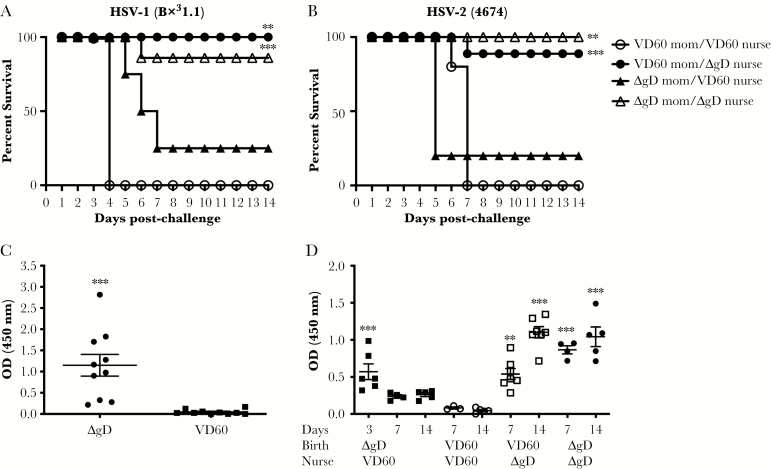Figure 4.
Optimal protection requires both transplacental and breastmilk-acquired antibodies (Abs). Female mice were prime-boost vaccinated with either ΔgD-2 or VD60 cell lysate, mated, and monitored for birth. Pups born to ΔgD-2-immunized mothers were switched and nursed by VD60-immunized mothers (only transplacental maternal Ab transfer), and mice born to VD60-immunized mothers were nursed by ΔgD-2-immunized mothers (only breastmilk-acquired Abs). Pups were challenged intranasally on Day of life 7 or 14 with (A) 105 plaque-forming units (pfu) of herpes simplex virus HSV-1(B3x1.1) or (B) 103 pfu of HSV-2(4674) and monitored for survival. (C). Breastmilk was obtained from ΔgD-2- or VD60-immunized mothers on postgestational day 8, and HSV-specific immunoglobulin G (IgG) was determined using enzyme-linked immunosorbent assay (ELISA) with HSV-2 infected cell lysates. (D). Serum was obtained on Days 3, 7, and 14 from pups born to and nursed by the indicated dams (without being inoculated with virus), and HSV-specific IgG was determined using ELISA with HSV-2-infected cell lysates; results are presented as optical density units (OD) with 1:1000 dilution of serum. Each point represents results for single pup. Survival was compared by Kaplan-Meier test (A and B) and Ab response by Student’s t test (C) or analysis of variance with Tukey’s multiple comparison test (D) relative to VD60 control (**, P < .01; ***, P < .001).

